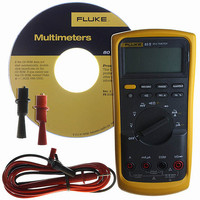FLUKE-83-5 Fluke Electronics, FLUKE-83-5 Datasheet - Page 38

FLUKE-83-5
Manufacturer Part Number
FLUKE-83-5
Description
MULTIMETER INDUSTRIAL
Manufacturer
Fluke Electronics
Series
8xr
Type
Digital (DMM)r
Specifications of FLUKE-83-5
Includes
Battery, Clips, Test Leads
Style
Handheld
Display Digits
4.5
Display Type
LCD, Bar Graph
Display Count
20000
Function
Voltage, Current, Resistance, Capacitance, Frequency
Functions, Extra
Continuity, Diode Test
Features
Auto Off, Backlight, Clips, Hold, Min/Max/Ave
Ranging
Auto/Manual
Response
Average
Lead Free Status / RoHS Status
Lead free / RoHS Compliant
Other names
2075004
614-1086
83-5
FLUKE-83-5
614-1086
83-5
FLUKE-83-5
Users Manual
Determining Pulse Width
For a periodic waveform (its pattern repeats at equal time
intervals), you can determine the amount of time that the
signal is high or low as follows:
1.
2.
3.
30
Measure the signal's frequency.
Press
duty cycle. Press E to select a measurement of
the signal's positive or negative pulse, refer to Figure
9.
Use the following formula to determine the pulse
width:
G
(in seconds)
Pulse Width = % Duty Cycle
a second time to measure the signal's
Frequency
100
Bar Graph
The analog bar graph functions like the needle on an
analog meter, but without the overshoot. The bar graph
updates 40 times per second. Because the graph
responds 10 times faster than the digital display, it is
useful for making peak and null adjustments and
observing rapidly changing inputs. The graph is not
shown for capacitance, frequency counter functions,
temperature, or peak min max.
The number of lit segments indicates the measured value
and is relative to the full-scale value of the selected
range.
In the 60 V range, for example, the major divisions on the
scale represent 0, 15, 30, 45, and 60 V. An input of -30 V
lights the negative sign and the segments up to the
middle of the scale.
The bar graph also has a zoom function, as described
under "Zoom Mode".










